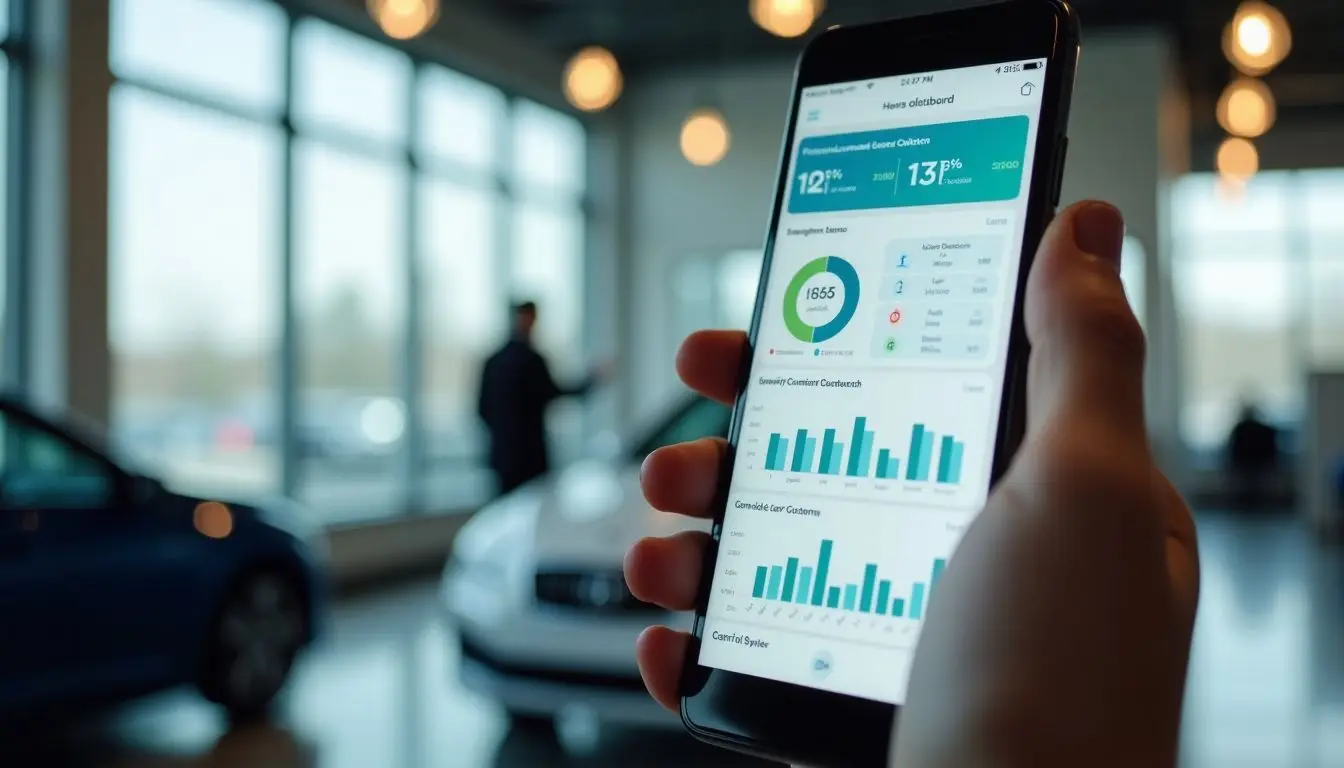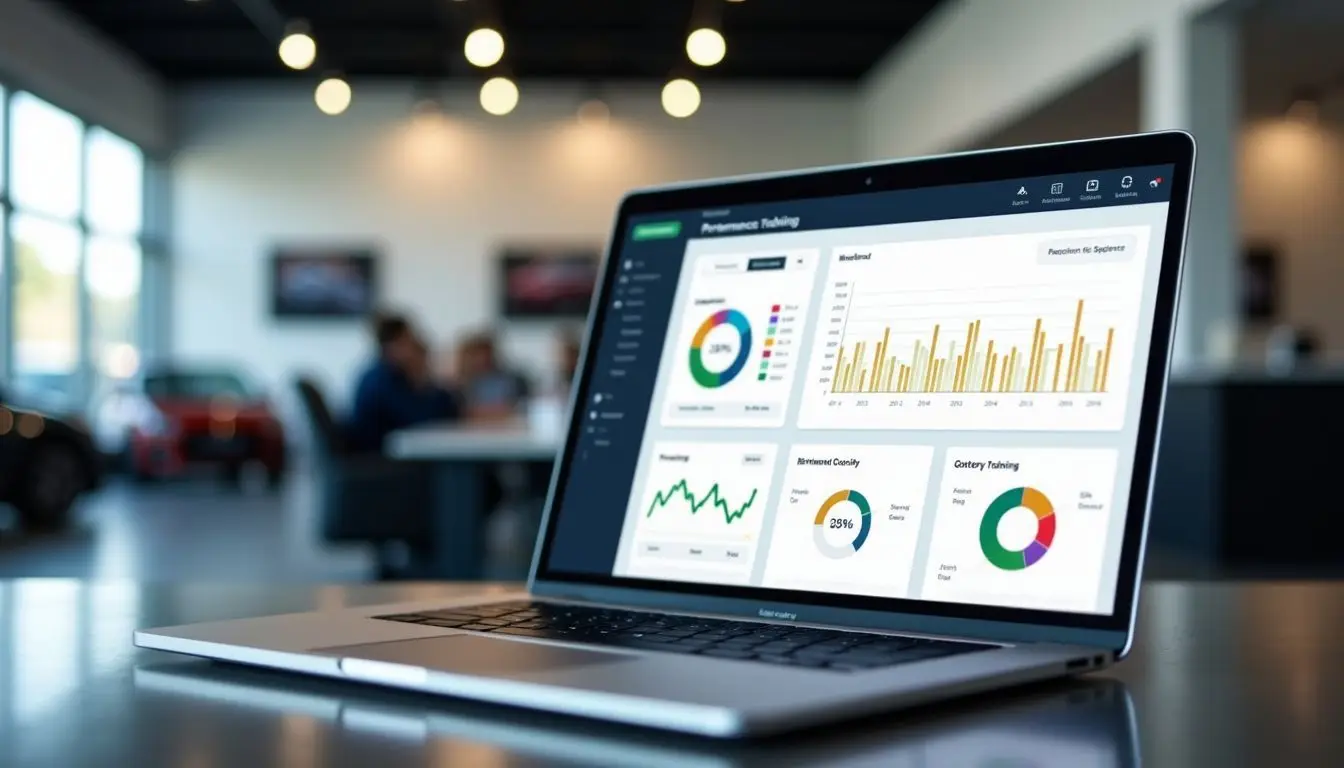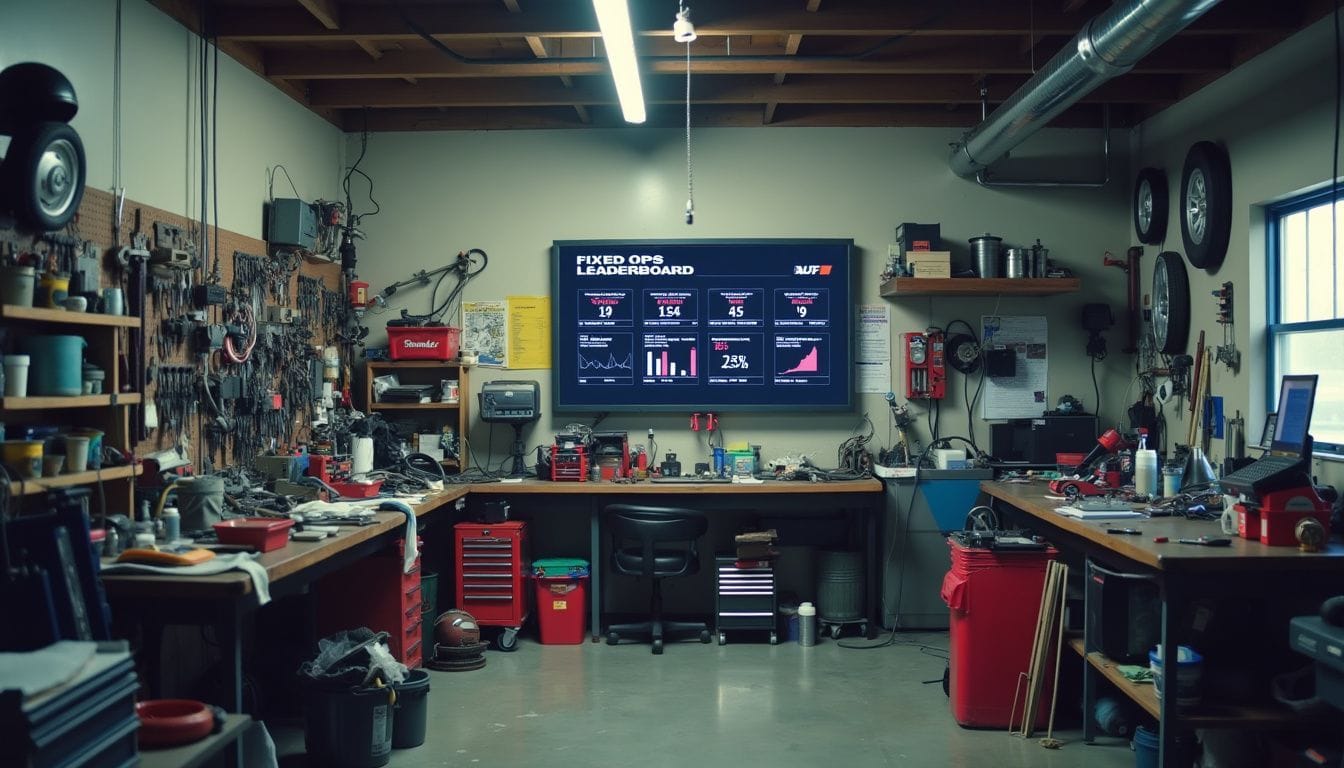In today’s fast-paced world, car dealerships are always looking for ways to sell more cars and provide top-notch service. But one big challenge they face is figuring out how well their sales teams are doing in real time.
Luckily, Digital Sales Performance Tracking can help solve this problem.
One important fact is that Automotive Sales BDC (Business Development Center) plays a key role in connecting with customers and boosting sales. Our blog will show you how tracking BDC metrics can improve dealership sales success.
You’ll learn about the power of digital tools that make monitoring progress easy and effective. Ready to see your dealership thrive? Keep reading!
Key Takeaways
- Digital tools help car dealerships track how well sales teams perform. They show important numbers in real time.
- Key things to watch include how many leads turn into sales and how quickly staff talk to customers.
- Using digital dashboards makes it easy for teams to see their progress and improve.
- Training and setting clear goals are good ways to make the BDC team do better.
- Checking on performance often helps find what works best, keeping both customers and workers happy.
Understanding BDC Performance Metrics
 BDC performance metrics help dealerships track their success. These numbers show how well the team is doing in connecting with customers and turning leads into sales.
BDC performance metrics help dealerships track their success. These numbers show how well the team is doing in connecting with customers and turning leads into sales.
Importance of BDC Metrics in car dealerships
 BDC metrics are very important for car dealerships. They help in understanding dealer performance. Automotive BDC relies on data to guide both sales and customer service. Tracking these metrics shows how well the dealership is connecting with customers.
BDC metrics are very important for car dealerships. They help in understanding dealer performance. Automotive BDC relies on data to guide both sales and customer service. Tracking these metrics shows how well the dealership is connecting with customers.
This includes tracking lead engagement and customer outreach efforts.
Sales BDC performance tracking can assist in reaching ultimate success. It helps dealerships monitor the effectiveness of their sales teams in real time. By focusing on key performance indicators, dealerships can improve their operations and drive revenue growth.
Digital Sales Performance Tracking is crucial for unlocking the potential of automotive sales BDC.
Key metrics to track (e.g. lead conversion rate, call connection rate, etc.)

Tracking key metrics is essential for a successful BDC in the automotive industry. These numbers help dealerships improve sales performance and customer service.
- Lead Conversion Rate: This metric shows how many leads turn into sales. A high conversion rate means the team is doing a good job at following up on potential customers.
- Call Connection Rate: This measures how often calls are connected with customers. A strong connection rate indicates effective outreach and communication skills.
- Follow-Up Time: This tracks how long it takes to follow up with leads after their inquiry. Quick responses can increase customer satisfaction and boost conversion rates.
- Customer Retention Rate: This number shows how well the dealership keeps its customers over time. High retention means satisfied customers who are likely to return for future purchases or services.
- Appointment Set Ratio: This metric reveals how many leads result in set appointments for test drives or consultations. A higher ratio suggests that the staff is skilled at engaging potential buyers.
- Sales per Agent: Tracking this helps measure individual sales team performance within the BDC. It highlights top performers and areas where others may need training or support.
- Response Time to Leads: Fast responses can make a big difference in securing a sale. Dealers should aim to respond to inquiries as quickly as possible to keep prospects engaged.
- Cost per Lead: Understanding this cost helps evaluate the efficiency of marketing efforts. Lower costs can lead to better profit margins when converting leads into sales.
- Sales Growth Over Time: Monitoring sales trends helps dealerships understand overall performance changes throughout various periods, like months or years, helping them adapt strategies accordingly.
- Customer Feedback Scores: Collecting feedback from clients provides insights into their experiences with the dealership’s services and staff interactions, driving improvements in service quality and enhancing customer relationships.
These metrics give car dealerships clear insights into their BDC operations and help propel success through digital tracking methods, leading to improved automotive sales performance.
Implementing Digital Sales Performance Tracking
![]()
Digital sales performance tracking can boost your BDC results. It replaces old methods like printed reports with easy-to-read digital dashboards.
Benefits of using digital dashboards

Digital dashboards provide clear insights for car dealerships. They show BDC performance metrics in real time. This allows teams to track sales potential immediately. Using digital tools replaces old methods like printed reports and dry-erase boards.
With data at their fingertips, staff can respond quickly to customer needs.
Sales BDC metrics become easier to understand through these dashboards. They help identify trends in lead conversion rates and call connection rates. A dashboard connects different areas of the dealership, including marketing, sales, and customer service.
It empowers teams to drive revenue growth while keeping customers happy. Digital Sales Performance Tracking is vital for enhancing overall dealer performance growth.
Replacing traditional methods (printed reports, dry-erase boards)
Car dealerships can replace old methods like printed reports and dry-erase boards with digital tools. Digital Sales Performance Tracking allows for real-time monitoring of BDC activities.
This system helps measure key BDC metrics effectively. It shows lead conversion rates and call connection rates at a glance.
Shifting to digital platforms improves efficiency in the BDC Business Development Center. It connects marketing, sales, and customer service seamlessly. Using software also provides detailed analysis, guiding teams toward better performance.
Dealer management systems can integrate these new tools easily, making transitions smoother than before.
Integration with existing dealership management systems
Integrating digital sales performance tracking with existing dealership management systems is vital. This connection helps car dealerships improve their operations. BDC teams can access real-time data on sales and customer service.
They rely on this information to guide their actions.
The Sales CRM plays a key role in this integration. It drives revenue growth while enhancing customer connections. Keeping track of BDC metrics boosts efficiency across the board. Using digital dashboards instead of printed reports makes it easier to monitor progress and make adjustments quickly.
This seamless link between marketing, sales, and customer service strengthens overall performance, paving the way for success in automotive sales BDC.
Tracking and Analyzing BDC Data
![]()
Tracking BDC data helps improve team performance. Use the right tools to analyze key numbers and boost efficiency.
Utilizing automotive analytics for BDC efficiency
Automotive analytics helps BDC teams work better. It uses data to improve sales and service. Tracking metrics like lead conversion rates gives clear insights. This allows dealerships to see what works and what needs change.
Effective digital tracking shows real-time performance for quick adjustments.
These tools connect marketing, sales, and customer service smoothly. By focusing on key performance indicators (KPIs), BDCs can find areas for growth easily. Sales CRM also plays a role here by enhancing communication with customers.
Overall, using analytics boosts the efficiency of automotive sales BDC directly.
Focus on key performance indicators (KPIs)
Key performance indicators (KPIs) are vital for assessing BDC success. They shine a light on areas needing improvement.
- Lead Conversion Rate: This metric shows how many leads turn into sales. A high rate means the team is effective in closing deals. It helps dealerships understand their sales potential better.
- Call Connection Rate: This measures how often team members connect with potential customers over the phone. A higher percentage indicates strong outreach skills. Tracking this helps improve communication strategies.
- Customer Response Time: This KPI tracks how quickly BDC staff respond to inquiries. Fast responses can lead to increased customer satisfaction and higher chances of conversion.
- Appointment Set Rate: This indicates the number of appointments scheduled from leads reached out to by the BDC team. Higher rates show that staff effectively engage prospects and create interest in visiting the dealership.
- Follow-Up Call Success Rate: This metric reflects the effectiveness of follow-up calls made after initial contact with leads. A high rate suggests strong engagement and persistence by the sales team.
- Sales Per Agent: Tracking sales generated by individual agents can identify top performers and those needing support or training, ensuring all members reach their potential.
- Customer Satisfaction Scores: Collecting feedback from customers allows dealerships to gauge satisfaction levels with BDC interactions, helping improve service quality over time.
- Cost Per Lead (CPL): Calculating CPL helps dealerships understand their marketing efficiency in attracting leads, assisting budget allocation for future campaigns.
- Lead Source Effectiveness: This involves analyzing which marketing sources provide the best leads for conversions, allowing better focus on successful channels and optimizing marketing efforts.
- BDC Team Training Impact: Monitoring performance before and after training programs provides insight into how education affects team productivity, leading to more informed training investments in automotive sales metrics.
Best practices for tracking and analyzing data
Tracking and analyzing data is key for improving automotive sales BDC performance. Following best practices can lead to better results.
- Use Digital Dashboards: Digital dashboards provide real-time data on sales BDC metrics. They replace old methods like printed reports and dry-erase boards, making it easier to see progress at a glance.
- Focus on Key Metrics: Tracking vital metrics like lead conversion rate and call connection rate helps in understanding dealer performance. These numbers show how well the BDC team connects with customers.
- Integrate with CRM Systems: A Sales CRM integrates into existing dealership management systems. This setup streamlines operations and makes tracking more efficient.
- Set Clear KPIs: Define clear key performance indicators (KPIs) for your team. Regularly reviewing these goals keeps everyone focused and motivated.
- Analyze Trends Over Time: Look at the data over weeks or months to find patterns. Understanding trends helps to make informed decisions about future strategies.
- Encourage Team Feedback: Invite team members to share their thoughts on BDC processes. Their insights can highlight areas needing improvement and boost morale.
- Train Staff Regularly: Provide ongoing training on tools for tracking sales metrics. Well-informed staff are more likely to succeed in today’s digital landscape.
- Celebrate Achievements: Recognize individual or team successes in achieving sales goals. Celebrating wins motivates the team and promotes a positive work environment.
- Utilize Automotive Analytics Tools: Use analytics specifically designed for the automotive market. These tools enhance efficiency by providing precise insights into customer outreach and acquisition efforts.
- Regularly Review Data Processes: Keep evaluating how data is tracked and analyzed within the dealership’s operations. Adjusting processes ensures they remain effective as needs change in automotive marketing landscapes.
Implementing these practices will propel success with digital sales performance tracking, ultimately unlocking automotive sales BDC potential.
Motivating and Improving BDC Performance

Motivating your BDC team is key to better performance. Use leaderboards to spark competition and encourage success. Create a positive environment with tips that boost morale. This can drive your dealership forward.
Want more ideas on enhancing BDC? Keep reading!
Enhancing team motivation with leaderboards
Leaderboards can boost team motivation in a BDC. They show real-time results and rankings for each team member. This creates friendly competition among staff. When everyone sees their progress, they feel more driven to improve.
Using leaderboards helps raise performance levels across the board. Teams become aware of key metrics like lead conversion rates and call connection rates. By tracking these numbers, employees strive to hit higher targets.
Digital Sales Performance Tracking is key here. It supports transparency and gives instant feedback that employees can use to enhance their skills and drive success in automotive sales BDC activities.
Tips for success
Success in automotive sales BDC requires strong strategies. These tips can help improve your team’s performance.
- Track Key Metrics: Focus on important BDC metrics like lead conversion rate and call connection rate. This gives a clear picture of how well the team is doing.
- Use Digital Dashboards: Implement digital sales performance tracking with dashboards. These tools provide real-time data and streamline reports, replacing old methods like printed reports or dry-erase boards.
- Integrate Systems: Link the digital dashboard with existing dealership management systems. This makes it easier for teams to access data and understand their performance quickly.
- Analyze Data Regularly: Utilize automotive analytics for BDC efficiency. Look at key performance indicators (KPIs) often to spot areas needing improvement.
- Motivate the Team: Create leaderboards to show team members’ standings based on performance. This builds friendly competition and encourages everyone to do their best.
- Offer Training Programs: Provide training sessions that focus on improving skills in customer outreach and service. A well-trained team is more effective in achieving results.
- Set Clear Goals: Establish clear and achievable goals for each member of your BDC team. This helps them stay focused and strive for success daily.
- Encourage Feedback: Create a culture where team members feel comfortable sharing ideas or challenges they face. Open communication can lead to new solutions and better results over time.
- Celebrate Wins: Recognize achievements, both big and small, within the team regularly. Celebrating success boosts morale and keeps motivation high among staff members.
- Review Strategies Often: Consistently review your dealership optimization strategies based on data insights from tracking metrics and KPIs. Adjust plans as needed to keep improving overall performance in automotive sales BDC activities.
Each of these tips plays a role in unlocking automotive sales BDC potential effectively, allowing dealerships to cultivate stronger customer relationships while driving revenue growth through enhanced employee engagement strategies.
Incorporating BDC metrics into dealership optimization strategies
BDC metrics play a crucial role in dealership optimization strategies. They help connect different parts of the business, like marketing and customer service. This connection allows for better outreach and acquisition of customers in both sales and service.
Using BDC performance tracking improves sales efficiency. It provides real-time insights into how the sales team is performing. Dealerships can make quick decisions based on accurate data from their digital dashboards.
This, in turn, enhances customer connections while driving revenue growth through effective strategies. Unlocking Automotive Sales BDC potential relies heavily on these metrics to propel success.
Conclusion

Tracking BDC performance is key to success. It helps dealerships understand sales and service better. Using digital tools makes this process easy and fast. The right metrics deliver clear insights for improvement.
Embrace these strategies to boost your dealership’s growth today.
For more tips and resources, keep learning about digital sales tracking options that fit your needs. Remember, small changes can lead to big wins in the automotive sales industry! Take action now for a brighter future in your business.
FAQs
1. What does “Unlocking Automotive Sales BDC Potential: Propel Success with Digital Sales Performance Tracking” mean?
This refers to using digital tools and AI to boost the success of an automotive sales business development center (BDC). It involves tracking sales performance online.
2. How is the Internet department involved in this process?
The Internet department plays a key role in this digital approach by managing online customer interactions, tracking digital sales performance, and leveraging AI technologies.
3. Can you explain how AI is revolutionizing automotive sales?
AI helps streamline the sales process by predicting customer behavior, personalizing marketing strategies, and automating routine tasks. This leads to increased efficiency and higher sales.
4. Is there a specific model for implementing these changes?
While there’s no one-size-fits-all model, businesses can start by integrating their BDC with their internet department. They can then use AI tools for tracking performance and making data-driven decisions.





